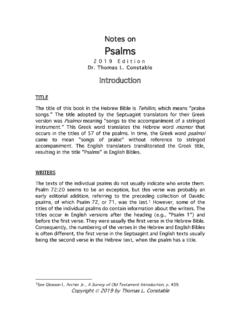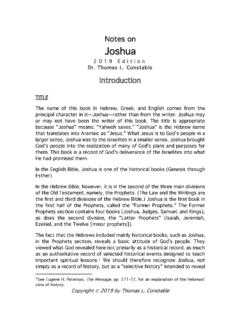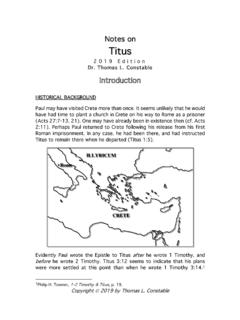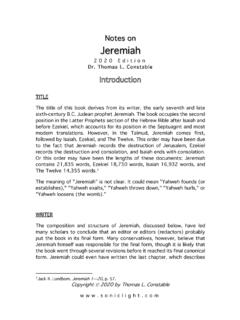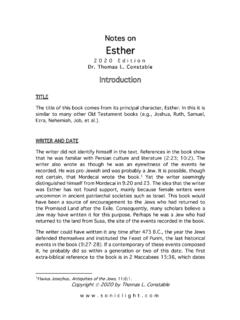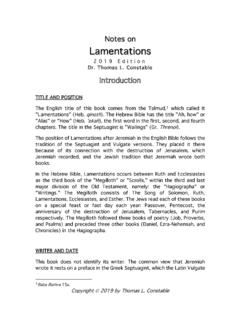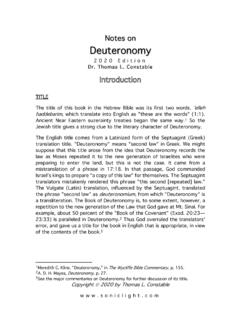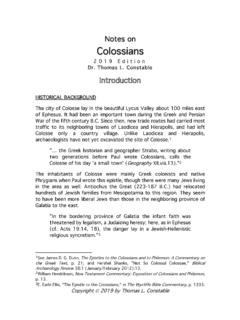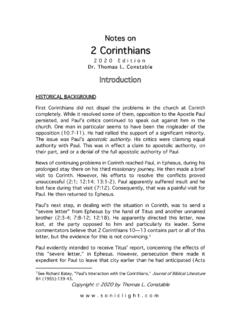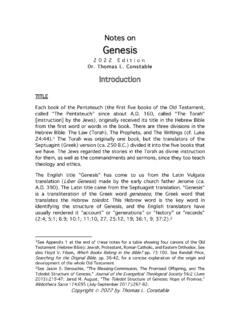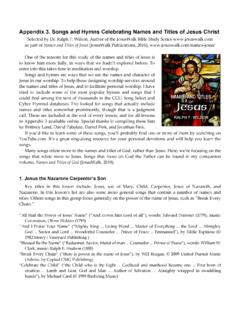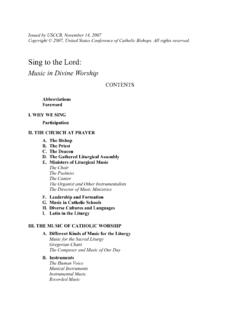Transcription of Notes on Exodus - Plano Bible Chapel
1 Notes on Exodus 2 0 2 1 E d i t i o n Dr. Thomas L. Constable TITLE. The Hebrew title of this book (we'elleh shemot) originated from the ancient practice of naming a Bible book after its first word or words. "Now these are the names of" is the translation of the first two Hebrew words. "The Hebrew title of the Book of Exodus , therefore, was to remind us that Exodus is the sequel to Genesis and that one of its purposes is to continue the history of God's people as well as elaborate further on the great themes so nobly introduced in Genesis."1. Exodus cannot stand alone, in the sense that the book would not make much sense without Genesis. The very first word of the book, translated "now," is a conjunction that means "and.". The English title " Exodus " is a transliteration of the Greek word Exodus , from the Septuagint translation, meaning "exit," "way out," or "departure.". The Septuagint translators gave the book this title because of the major event in it, namely, the Israelites' departure from Egypt.
2 "The Exodus is the most significant historical and theological event of the Old Testament "2. DATE AND WRITER. Moses, who lived from about 1525 to 1405 , wrote Exodus (17:14;. 24:4; 34:4, 27-29). He could have written it, under the inspiration of the 1 Ronald Youngblood, Exodus , pp. 9-10. 2 Eugene H. Merrill, Kingdom of Priests, p. 57. Copyright 2021 by Thomas L. Constable 2 Dr. Constable's Notes on Exodus 2021 Edition Holy Spirit, any time after the events recorded (after about 1444 ). He may have written it during the year the Israelites camped at the base of Mt. Sinai. He might have done so during the 38-year period of wandering in the wilderness, following the Israelites' failure to enter the land from Kadesh Barnea (cf. Num. 13-14; ca. 1443-1405 ). On the other hand, he may have written it on the plains of Moab, just before his death (cf. 16:35).1. These dates tie in with the date of the Exodus of the Israelites from Egypt, which will be discussed in the exposition of chapter 12 below.
3 The founding president of Brandeis University wrote the following about Moses: "Yet of his life, of his very existence, we have no conclusive proof. Not a contemporaneous document, not a stele, not a shred of evidence, has been found to authenticate his historicity. Perhaps some day his existence, too, will be scientifically demonstrated, as Hammurabi's was, when, in 1902, the tablets of his laws were discovered."2. " most critics accept his [Moses'] historical existence, as a member of the Levi-Simon-Judah tribes, and, while discounting the subsequent idealization of his character and career, place him among the great religious leaders of all time."3. 1On the date of the Exodus , see my note at the end of 12:37-42; Tremper Longman III. and Raymond B. Dillard, An Introduction to the Old Testament, pp. 65-69; or John D. Hannah, " Exodus ," in The Bible Knowledge Commentary: Old Testament, pp. 104-5.
4 On the Mosaic authorship of Exodus , see my note on the writer of Genesis and the sources referred to there, in my Notes on Genesis. Kenneth Kitchen, "The Old Testament in its Context: 2 From Egypt to the Jordan," Theological Students' Fellowship Bulletin (1971):4- 8, also has helpful background information on the Mosaic authorship of Exodus , Leviticus, Numbers, and Deuteronomy, as does Gleason L. Archer, "Old Testament History and Recent Archaeology from Moses to David," Bibliotheca Sacra 127:506 (April-June 1970):99-106. 2 Abram Sachar, A History of the Jews, p. 16. 3 Ibid., p. 20. 2021 Edition Dr. Constable's Notes on Exodus 3. SCOPE. Exodus embraces about 431 years of history, from the arrival of Jacob and his family in Egypt (ca. 1876 ) to the erection of the tabernacle in the wilderness of Sinai (ca. 1445 ). However, 1:1-7 is a review of Jacob's family. If we eliminate this section, the narrative resumes the story of the Israelites where Genesis ends, after the death of Joseph.
5 About 364 years elapsed between the death of Joseph and the building of the tabernacle. The bulk of the book (chs. 3 40) deals with only two of those years, the year before and the year after the Exodus from Egypt. The Exodus event is clearly the focus of this book. The Israelites lived in Egypt 430 years (12:40). Genesis 15:13 has the rounded number "400 years" as the total time of Israel's oppression in PURPOSE. "The purpose of the Book of Exodus is to celebrate God's gracious deliverance of His chosen people Israel from Egyptian slavery to the freedom of covenant relationship and fellowship with Him."2. GENRE. Like Genesis, Exodus contains a mixture of literary genres, including narrative, poetry, legal, and As a whole, however, it seems best to classify the whole book as theological instructional 1 See the "Chronology Chart for Exodus " in John Davis, Moses and the Gods of Egypt, p. 14.
6 2 Eugene H. Merrill, in The Old Testament Explorer, p. 41. 3 Herbert M. Wolf, An Introduction to the Old Testament Pentateuch, p. 127. 4 Longman and Dillard, p. 72. 4 Dr. Constable's Notes on Exodus 2021 Edition IMPORTANCE. "No other biblical book surfaces elsewhere in the OT as frequently as the Book of Exodus does; in the NT only the Books of Psalms and Isaiah are cited more, and that for the fairly obvious reasons of liturgy and messianism."1. "The deliverance of Israel out of Egypt by Yahweh in the Old Testament is parallel in importance to the resurrection of Christ in the New Testament. The historicity of these events is a critical foundation for a proper understanding of the rest of the Bible ."2. OUTLINE. I. The liberation of Israel 1:1 15:21. A. God's preparation of Israel and Moses chs. 1 4. 1. The growth of Jacob's family 1:1-7. 2. The Israelites' bondage in Egypt 1:8-22. 3. Moses' birth and education 2:1-10.
7 4. Moses' flight from Egypt to Midian 2:11-15. 5. Moses' life in Midian 2:16-25. 6. Moses' call 3:1 4:18. 7. Moses' return to Egypt 4:19-31. B. God's demonstrations of His sovereignty chs. 5 11. 1. Pharaoh's response to Moses and Aaron's initial request 5:1 6:1. 2. Moses and Aaron's equipment as God's messengers 6:2 7:7. 3. The attestation of Moses and Aaron's divine mission 7:8- 13. 4. The first three plagues 7:14 8:19. 5. The fourth, fifth, and sixth plagues 8:20 9:12. 1 John I. Durham, Exodus , p. xxiii. 2J. Daniel Hays, "An Evangelical Approach to Old Testament Narrative Criticism,". Bibliotheca Sacra 166:661 (January-March 2009):13. 2021 Edition Dr. Constable's Notes on Exodus 5. 6. The seventh, eight, and ninth plagues 9:13 10:29. 7. The proclamation of the tenth plague ch. 11. C. God's redemption of His people 12:1 13:16. 1. The consecration of Israel as the covenant nation 12:1- 28.
8 2. The death of the firstborn and the release of Israel 12:29-36. 3. The Exodus of Israel out of Egypt 12:37-42. 4. Regulations concerning the Passover 12:43-51. 5. The sanctification of the firstborn 13:1-16. D. God's completion of Israel's liberation 13:17 15:21. 1. The journey from Succoth to Etham 13:17-22. 2. Israel's passage through the Red Sea ch. 14. 3. Israel's song of deliverance 15:1-21. II. The adoption of Israel 15:22 40:38. A. God's preparatory instruction of Israel 15:22 18:27. 1. Events in the wilderness of Shur 15:22-27. 2. Quails and manna in the wilderness of Sin ch. 16. 3. The lack of water at Rephidim 17:1-7. 4. The hostility of the Amalekites 17:18-36. 5. The friendliness of Jethro the Midianite ch. 18. B. The establishment of the Mosaic Covenant 19:1 24:11. 1. Preparation for the Covenant ch. 19. 2. The Ten Commandments 20:1-17. 3. The response of the Israelites 20:18-21.
9 4. The stipulations of the Book of the Covenant 20:22 . 23:33. 5. The ratification of the Covenant 24:1-11. C. Directions regarding God's dwelling among His people 24:12 . 31:18. 1. The revelation of these directions 24:12-18. 6 Dr. Constable's Notes on Exodus 2021 Edition 2. Contributions for the construction of the sanctuary 25:1-9. 3. The tabernacle furnishings 25:10-41. 4. The tabernacle structure ch. 26. 5. The tabernacle courtyard 27:1-19. 6. The investiture of the priests 27:20 28:43. 7. The consecration of the priests 29:1-37. 8. The service of the priests 29:38 30:38. 9. The builders of the tabernacle 31:1-11. 10. The sign of the Sabbath 31:12-18. D. The breaking and renewing of the covenant chs. 32 34. 1. The failure of Israel ch. 32. 2. The re-establishment of fellowship ch. 33. 3. The renewal of the covenant ch. 34. E. The construction and dedication of the objects used in Israel's worship chs.
10 35 40. 1. Preparations for construction 35:1 36:7. 2. Execution of the work 36:8 39:43. 3. The erection and consecration of the tabernacle ch. 40. In an interesting and original chart of Exodus , Ted Grove suggested the following structural outline of I. Israel's liberation chs. 1 18. A. Israel's affliction (Israel is Egypt's possession) 1:1 2:14. B. Deliverance 2:15 18:27. Ted saw the following chiastic structure in this section. A Midian: Moses' commission 2:15 4:28. B Enemy: Egypt defeated 4:29 15:21. C Water: bitter to sweet and 12 springs 15:22-27. 1 Ted was a student in my Old Testament History I course in the spring of 1991. 2021 Edition Dr. Constable's Notes on Exodus 7. D Food: manna and quail ch. 16. C' Water: out of rock 17:1-7. B' Enemy: Amalek defeated 17:8-16. A' Midian: Moses accepts wisdom ch. 18. II. Israel's adoption chs. 19 40. A. Covenant delivered 19:1 24:11. B. Sanctuary planned 24:12 31:18.
